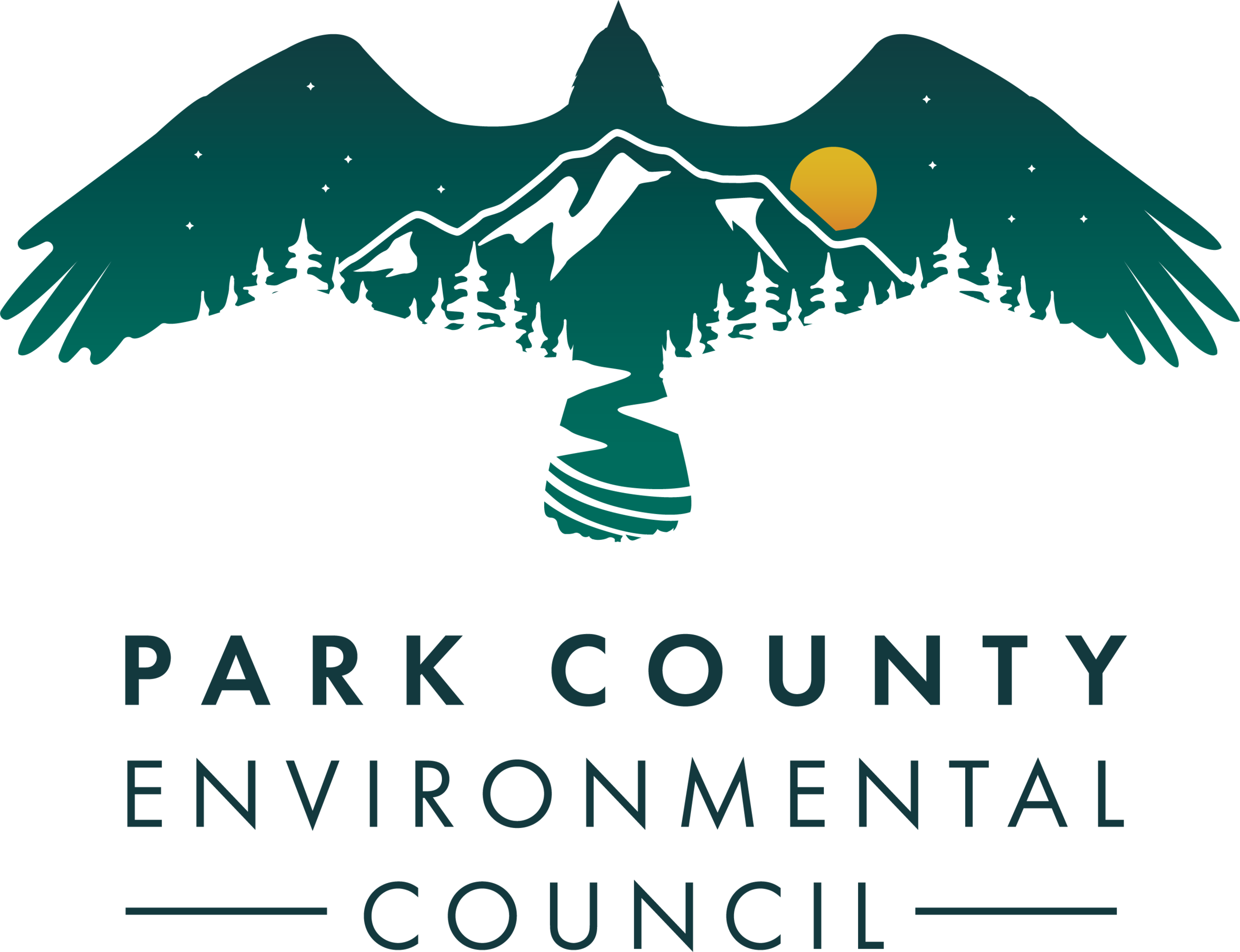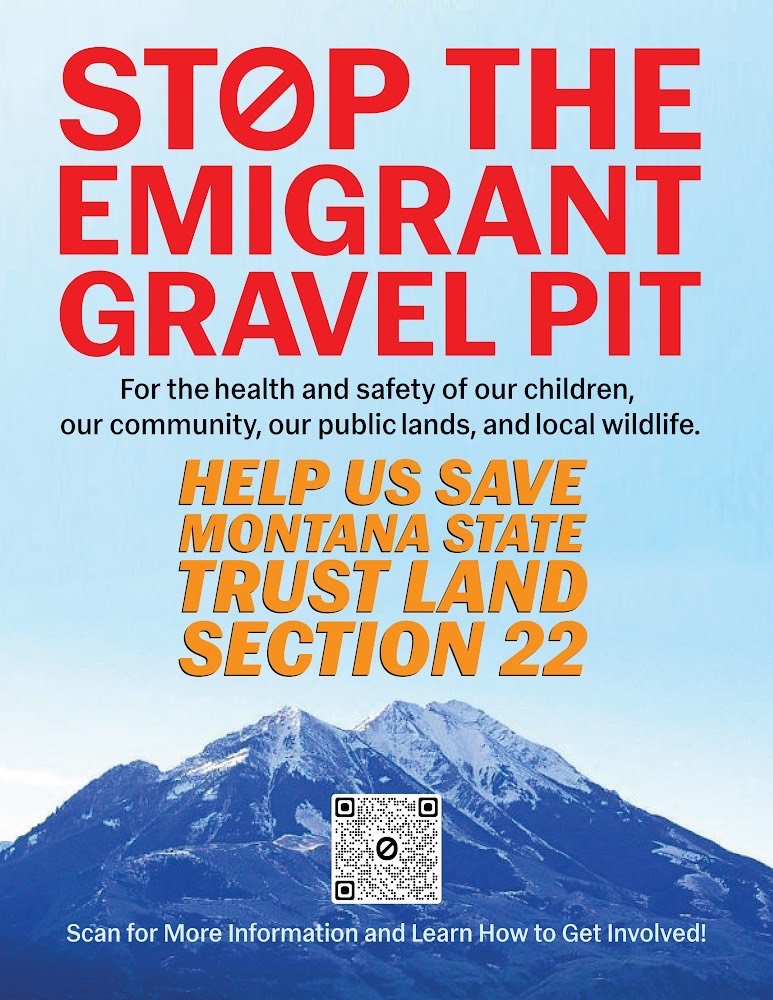CROSSROADS: Four steps you can take to help community planning efforts today!
Today, I'm writing with four steps that you can take to help our community planning efforts.
Those action items include:
Tell Gov. Greg Gianforte this Thursday a gravel pit on state land near Emigrant doesn’t make sense.
Don’t sign the petition to repeal the Park County Growth Policy.
Attend the August 17 Park County Planning Board meeting to tell them to do something about the growing industrial and commercial threats (think glamping and gravel pits).
Take the Livingston Downtown Master Plan Survey.
Learn more about each item below!
1. Tell the Governor we don’t want a gravel pit near Emigrant.
This Thursday, August 10, Gov. Greg Gianforte will be at the Emigrant Outpost at 8:30 a.m. to hear your concerns about what’s going on in Montana.
We’re hoping that people will show up to tell the governor we don’t want a gravel pit on state land north of Emigrant. The land is currently rich wildlife habitat for many species and has rich cultural resources. Paradise Valley has numerous gravel resources already, and we need to tell the governor it doesn’t make sense to develop a new gravel pit and pollute the air and water of Paradise Valley.
Let us know if you plan to go! Email Karrie at karrie@pcecmt.org.
2. Don’t sign the petition to repeal the Park County Growth Policy.
At its core, a growth policy includes big-picture goals, measurable objectives, and sets policies that will assist the County Commissioners in making decisions about how to manage county resources. It is designed to be results-oriented and includes an implementation section describing actions, a timeline, and partners who will help carry out the actions.
- 2017 Park County Growth Policy
As has happened before in Park County, there is a movement afoot to repeal the Park County Growth Policy. Specifically, signatures are being collected to place on the November ballot two actions that would:
1. Get rid of the current growth policy
2. Require voter approval before adoption of any future growth policy
Don’t sign the petition.
Do NOT sign the petition.
Growth Policy Repeal Petition Frequently Asked Questions
What is a growth policy?
A “Growth Policy” is Montana’s version of a comprehensive plan. Comprehensive plans are widely used in communities, cities, and counties to establish a vision to guide future growth and change. Montana state statute (76-1-601) sets out the contents that must be included in a growth policy and directs the planning board of a jurisdiction to make a recommendation on potential adoption of a growth policy to a city or county commission. Per statute, a growth policy is not a regulatory document.
Why is a growth policy important?
Growth policies are documents that help community members prepare for the future. They are intended to provide a comprehensive overview of things like population, housing needs, economic conditions, public facilities, natural resources, and other land uses to help prepare for the future, spend taxpayers’ money wisely, and help a community proactively respond to its needs rather than act after it might be too late.
What’s in the Park County Growth Policy?
The Park County Growth Policy was adopted in 2017 after broad citizen participation. It includes 178 pages of facts, figures, analyses, projections, as well as 17 goals, 42 objectives, and 143 action items. The key issues identified include: Intergovernmental coordination; water availability and quality; infrastructure; housing and; growth and development. Montana statute requires that a community reviews its growth policy “at least once every five years” to see if revisions are needed based on community change.
What happens if the Park County Growth Policy goes away?
If Park County no longer had a growth policy, the county would lose countless hours of collective work that went into studying issues like expanding broadband internet, building and maintaining trails, making county roads safe and efficient, obtaining federal funding to upgrade roads and help build and prepare bridges, creating partnerships to maintain solid waste and encouraging recycling, and developing housing to meet needs of all residents.
The word “zoning,” which seems to be the prime motivator behind the repeal effort, is mentioned just once in the growth policy. Zoning is one tool among many tools available to county residents to help prepare for the future. Opponents argue a growth policy is a “pre-condition for county zoning.” While true, a growth policy can help set the stage for responsible zoning, a growth policy offers so much more than a path to zoning.
Losing the Park County Growth Policy means no comprehensive coordination, no coordination with other local governments like Livingston, no neighborhood plans, no housing action plan, no billboard regulation, and no opportunity for sensible county-initiated zoning and/or emergency zoning.
Bottom line: A successful repeal of Park County’s Growth Policy would:
1. Stall and negate the Gardiner Neighborhood Plan (or any other neighborhood plan);
2. Nullify the Park County US Highway 89 South – East River Road – Old Yellowstone Trail Zoning District which regulates billboards;
3. Nullify the Park County Housing Action Plan;
4. Prevent adoption of any county-initiated zoning including emergency zoning;
5. Weaken county grant applications and;
6. Jeopardize future conservation easements in Park County, a voluntary method for preserving open land. It would negate the collective work of our community.
Why are we talking about this?
September 20 is the deadline to submit signatures from 15 percent of registered Park County voters to get the ballot measures before voters in November. According to the Park County Elections Office, there are 7,169 electors in the county (excluding Livingston & Clyde Park), which means 1,075 valid signatures of qualified electors are needed for each petition to make the ballot. If enough signatures per petition are collected, the measures automatically go on the ballot with no need for commission approval.
Don’t Sign the Petition
PCEC believes the repeal effort is misguided. While the Park County Growth Policy may not be a perfect reflection of what all community members think is best for our county, it represents countless hours of input in public settings. Over six years has passed since it was adopted, and it is clearly outdated after years of considerable change. It needs to be updated and an update needs to involve every resident who wishes to participate.
Wouldn’t it make more sense to review the old policy and figure out what needs more work? Perhaps we need to consider Objective 3.2 Increase support for rural fire districts? Or Goal 11 Provide for a safe and efficient county road network? Or Goal 12 Support water and sewer districts in and around community centers?
As Ken Hanawalt said in a recent county planning board meeting, perhaps there are goals and objectives from the current growth policy that need to be executed. Perhaps we can follow Hanawalt’s advice and work on some of the good ideas from the old growth policy, while working on new good ideas for a new growth policy?
3. Attend the Park County Planning Board meeting on Thursday, August 17 to tell them to do something about the growing industrial and commercial threats (think glamping and gravel pits).
In August, the Park County Planning Board will be holding a meeting to discuss the growing industrial threats facing Park County. Planning Board members said that they have been receiving an increasing number of complaints about issues like glamping, gravel pits and other threats. Join us on August 17th to share your concerns!
Please consider attending their next meeting on August 17, 5:30 pm in the community room of the City-County Courthouse.
Last year, Park County Commissioners tabled the conflict mitigation zoning proposal, allowing these uses to continue without any local oversight.
Join us in preparing for a strong future, a future our kids can be proud of, a future that prioritizes all the things we love about Park County.
We are encouraged by recent county planning board efforts to improve community engagement. Planning board members have spent the past couple months asking citizens the best methods to get the word out about county activities. These meetings and recommendations are likely to make some necessary changes in the way county government operates by building more awareness about events and hopefully, in the process, creating more trust. RSVP to let us know you can attend today!
This is good timing as we should take seriously the idea that being prepared for the future makes a lot more sense than being unprepared.
Park County Planning Board
Thursday, August 17, 5:00 p.m.
Community Room, City-County Complex, 414 E. Callender St.
The Park County Planning Board will meet for its regular monthly meeting. At the meeting, the Planning Board will hold a discussion of the 2017 Park County Growth Policy and efforts to update it.
We are hoping to have members of the public attend the meeting and express support for the Growth Policy and concerns about the increasing risk of industrial and commercial development (think glamping and gravel pits). RSVP to let us know you can attend today!
4. Take the Livingston Downtown Master Plan Survey
The City of Livingston just hired a consultant to lead our community through the Downtown Master Plan process!
Fill out the following survey to start your participation in the process: www.downtownlivingston.org/plan
This is our opportunity to help our community invest in a strong downtown, a safe and walkable downtown, and a vibrant Main Street for everyone.


